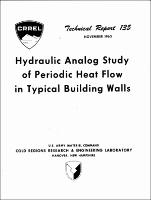Please use this identifier to cite or link to this item:
https://hdl.handle.net/11681/5666| Title: | Hydraulic analog study of periodic heat flow in typical building walls |
| Authors: | Thayer School of Engineering Hawk, Rhoderick Lamb, William Tribus, Myron |
| Keywords: | Exterior walls Walls Thermal properties Heat transfer Heat loss Heat transmission Heat flow Heat Computers Computer programs Fluidic computers |
| Publisher: | Cold Regions Research and Engineering Laboratory (U.S.) Engineer Research and Development Center (U.S.) |
| Series/Report no.: | Technical report (Cold Regions Research and Engineering Laboratory (U.S.)) ; 135. |
| Description: | Technical Report Summary: The purpose of this study was to determine transient heat flow through ten exterior building walls for an air-conditioned building having reversible heat flow during a 24-hour period. The building walls were of various construction types; however, they each had essentially the same total heat transmission coefficient of about 0.20 Btu/ft^2-hr-°F. The inside room air temperature was maintained at a constant 70°F. The variables involved in this study were the thermal capacitance of the walls and the distribution of capacitance and resistance within the wall sections. A hydraulic analog computer was programmed to record transient temperature within the walls, and cumulative heat flow and instantaneous heat flux into the room. Three different daily cyclic input temperatures at the outside wall surface, derived from data for September at Washington, D. C., contributed one of the boundary conditions. A photographic technique described herein proved useful in recording results of the computer study. The ability of each wall to dampen load fluctuations was determined as was the time lag of heat flow into the room. A comparison of the cumulative heat flow into the room during office hours was made for each type of exterior wall construction. This report contains: a description of the scaling technique used to program the computer (taking into consideration the time required for cancellation of transient effects), the thermal properties of the ten wall sections, an approximate analytical technique for checking the accuracy of computer results, and results of programming the hydraulic analog computer for both a step and a sinusoidal input function for which analytical results are available. Results obtained in this study are given on figures and tables contained herein. Walls having high thermal capacitance result in a large thermal time lag, thus permitting the wall to store heat during the day and thereby delay full capacity operation of air conditioners until after working hours. A "peak load factor" is defined which provides a reasonably accurate relative measure of a wall's ability to dampen heat flow variations in walls ; it is tentatively concluded that a wall's damping characteristics are improved when the thermal resistance and capacitance are evenly distributed throughout the wall. The results of the study also showed that the greater the thermal capacitance, the greater the damping ability of the wall ; this would be expected from theoretical considerations. It is concluded that the hydraulic analog computer can be successfully applied to solving heat flow problems subject to a few modifications necessary to reduce the average error of results. The influence of a building's location, the number of stories, required window space, and financial considerations governing construction are also factors involved in the selection of building walls in addition to air-conditioning requirements. It is recommended that the effects of direct radiation through windows, orientations of walls other than northerly, heat flow through the roof, and heat sources within the room be investigated more thoroughly before attempting to use the results of this study. |
| Rights: | Approved for public release; distribution is unlimited. |
| URI: | http://hdl.handle.net/11681/5666 |
| Appears in Collections: | Technical Report |
Files in This Item:
| File | Description | Size | Format | |
|---|---|---|---|---|
| CRREL-Technical-Report-135.pdf | 2.25 MB | Adobe PDF |  View/Open |